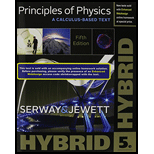
(a)
The speed of the laser beam when the spot of light on the wall is at distance
(a)
Answer to Problem 59P
The speed of the laser beam when the spot of light on the wall is at distance
Explanation of Solution
Let
From the Figure, write the expression for
Here,
Solve equation (I) for
Differentiate the equation (II) with respect to time, to find the speed of the laser spot at the wall.
From the Figure, using Pythagorean write the expression for
`
If the mirror turns through angle
Use equation (IV) and (V) in (III).
Conclusion:
Therefore, the speed of the laser beam when the spot of light on the wall is at distance
(b)
The value of the
(b)
Answer to Problem 59P
The value of the
Explanation of Solution
The speed of the laser beam when the spot of light on the wall is at distance
Conclusion:
Therefore, the value of the
(c)
The minimum value for the speed.
(c)
Answer to Problem 59P
The minimum value for the speed is
Explanation of Solution
The speed of the laser beam when the spot of light on the wall is at distance
Substitute,
Conclusion:
Therefore, the minimum value for the speed is
(d)
The maximum speed of the spot on the wall.
(d)
Answer to Problem 59P
The maximum speed of the spot on the wall is
Explanation of Solution
The maximum speed occurs when the reflected beam arrives at the corner of the room.
Substitute,
Conclusion:
Therefore, the maximum speed of the spot on the wall is
(e)
The time interval in which the spot changes from its minimum to maximum speed.
(e)
Answer to Problem 59P
The time interval in which the spot changes from its minimum to maximum speed is
Explanation of Solution
The reflected laser beam rotates through
The time interval between the minimum and maximum speed can b e calculated as follows,
Conclusion:
Substitute,
Therefore, the time interval in which the spot changes from its minimum to maximum speed is
Want to see more full solutions like this?
Chapter 25 Solutions
Principles of Physics: A Calculus-Based Text, Hybrid (with Enhanced WebAssign Printed Access Card)
- Hi! I need help with these calculations for part i and part k for a physics Diffraction Lab. We used a slit width 0.4 mm to measure our pattern.arrow_forwardExamine the data and % error values in Data Table 3 where the angular displacement of the simple pendulum decreased but the mass of the pendulum bob and the length of the pendulum remained constant. Describe whether or not your data shows that the period of the pendulum depends on the angular displacement of the pendulum bob, to within a reasonable percent error.arrow_forwardIn addition to the anyalysis of the graph, show mathematically that the slope of that line is 2π/√g . Using the slope of your line calculate the value of g and compare it to 9.8.arrow_forward
- An object is placed 24.1 cm to the left of a diverging lens (f = -6.51 cm). A concave mirror (f= 14.8 cm) is placed 30.2 cm to the right of the lens to form an image of the first image formed by the lens. Find the final image distance, measured relative to the mirror. (b) Is the final image real or virtual? (c) Is the final image upright or inverted with respect to the original object?arrow_forwardConcept Simulation 26.4 provides the option of exploring the ray diagram that applies to this problem. The distance between an object and its image formed by a diverging lens is 5.90 cm. The focal length of the lens is -2.60 cm. Find (a) the image distance and (b) the object distance.arrow_forwardPls help ASAParrow_forward
 Principles of Physics: A Calculus-Based TextPhysicsISBN:9781133104261Author:Raymond A. Serway, John W. JewettPublisher:Cengage Learning
Principles of Physics: A Calculus-Based TextPhysicsISBN:9781133104261Author:Raymond A. Serway, John W. JewettPublisher:Cengage Learning Physics for Scientists and EngineersPhysicsISBN:9781337553278Author:Raymond A. Serway, John W. JewettPublisher:Cengage Learning
Physics for Scientists and EngineersPhysicsISBN:9781337553278Author:Raymond A. Serway, John W. JewettPublisher:Cengage Learning Physics for Scientists and Engineers with Modern ...PhysicsISBN:9781337553292Author:Raymond A. Serway, John W. JewettPublisher:Cengage Learning
Physics for Scientists and Engineers with Modern ...PhysicsISBN:9781337553292Author:Raymond A. Serway, John W. JewettPublisher:Cengage Learning Physics for Scientists and Engineers: Foundations...PhysicsISBN:9781133939146Author:Katz, Debora M.Publisher:Cengage Learning
Physics for Scientists and Engineers: Foundations...PhysicsISBN:9781133939146Author:Katz, Debora M.Publisher:Cengage Learning Physics for Scientists and Engineers, Technology ...PhysicsISBN:9781305116399Author:Raymond A. Serway, John W. JewettPublisher:Cengage Learning
Physics for Scientists and Engineers, Technology ...PhysicsISBN:9781305116399Author:Raymond A. Serway, John W. JewettPublisher:Cengage Learning College PhysicsPhysicsISBN:9781285737027Author:Raymond A. Serway, Chris VuillePublisher:Cengage Learning
College PhysicsPhysicsISBN:9781285737027Author:Raymond A. Serway, Chris VuillePublisher:Cengage Learning





